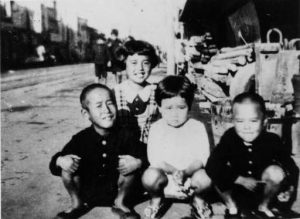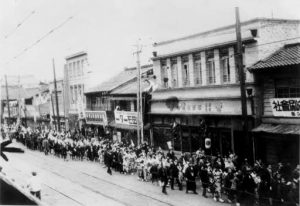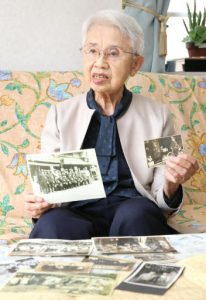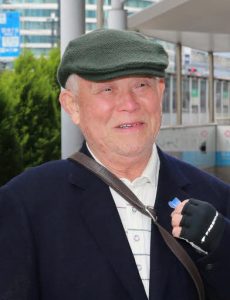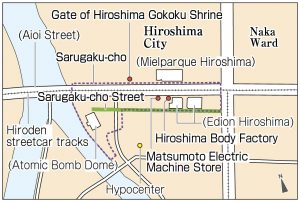Striving to fill voids in Hiroshima 75 years after the atomic bombing—Recreating cityscapes: 14 photos discovered that show bustle of former Sarugaku-cho
Jan. 1, 2021
Former residents of neighborhood, directly beneath A-bomb detonation, had held on to valuable photos
by Miho Kuwajima, Staff Writer
A total of 14 photographs taken before World War II in the former Sarugaku-cho, which was located directly beneath the atomic bomb’s detonation in Hiroshima’s Naka Ward and completely wiped out except for the Atomic Bomb Dome, have been found one after another. According to the Hiroshima Peace Memorial Museum, also located in the city’s Naka Ward, photos of Sarugaku-cho are rare, with few taken on the north side of Aioi Street having yet been discovered. All 14 photos vividly capture the cityscapes, including streets lined with shops.
In one of the photos, children squat on a street, smiling. The photo was taken around 1940 in the vicinity of the present-day Mielparque Hiroshima. Sumiko Hosono, 91, a former resident of Sarugaku-cho and now a resident of Nishi Ward, had held on to the photo. “It was taken in front of a warehouse owned by Mr. Saiku, a construction worker. We must have been playing hide-and-seek or something at the time.”
The Matsumoto Electric Machine Store, where Ms. Hosono’s family lived, was located to the south of the spot at which the photo was taken, diagonally across from the warehouse. Fusanosuke Matsumoto, Ms. Hosono’s father, repaired radios at the store. Around her parents’ house, a soy sauce shop, a Japanese-style hotel, and an ophthalmological clinic, among other buildings, stood side by side. “We were on good terms with one another, and the neighborhood was lively,” said Ms. Hosono. The atomic bombing devastated the area instantaneously, killing many of the residents. Fusanosuke, who was engaged in war efforts in Zakoba-cho to tear down houses to create fire lanes, fell victim to the atomic bombing.
Ms. Hosono experienced the atomic bombing in Funairikawaguchi-cho, where she had been mobilized for the war effort. Her father’s photo album escaped the fire, because he had left it at a relative’s house, as well as a commemorative photo of an air force defense corps taken on Sarugaku-cho Street in 1933 and a photo depicting rice-cake production at the Hiroshima Gokoku Shrine, then located at the site of the former Hiroshima Municipal Baseball Stadium. Hironobu Ochiba, 43, chief curator at the Hiroshima Peace Memorial Museum, said, “These photos are invaluable materials that tell of the lives before the war of the residents of the district beneath the A-bomb explosion.”
Tameo Nakagawa, 87, a resident of Hatsukaichi City, lived in his house at 61 Sarugaku-cho, three doors to the east of the Matsumoto Electric Machine Store. His house stood where the west wing of the present-day Edion Hiroshima is now located. His father Teruyoshi, who died at age 92 in 2004, owned the car repair shop Hiroshima Body Factory there. In a photo album left by Teruyoshi, there was a black-and-white photo taken in 1940 depicting a parade in celebration of the 2,600th year anniversary of Japan’s Imperial reign, and a black-and-white photo capturing Teruyoshi and Tameo, standing in front of an American car.
Mr. Nakagawa said, “The atomic bomb was dropped on top of us, and our neighborhood was reduced to rubble. But it was rebuilt beautifully thanks to everyone’s efforts.” Ms. Hosono decided to donate her photos to the Hiroshima Peace Memorial Museum after much hesitation. “I wanted to pass on the memories to future generations. I hope my photos are of some use.” Every one of the photos will convey family memories of the hometown, annihilated in the atomic bombing, to future generations.
(Originally published on January 1, 2021)

